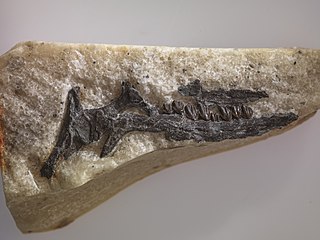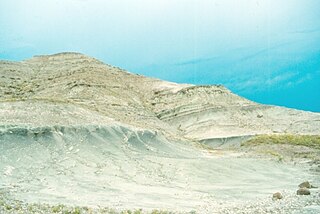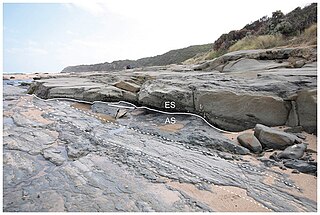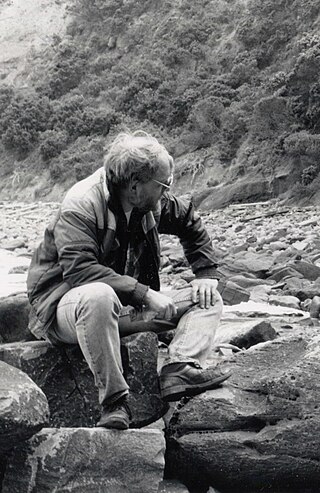
The South Polar region of the Cretaceous comprised the continent of East Gondwana–modern day Australia, Zealandia, and Antarctica–a product of the break-up of Gondwana in the Cretaceous Period. The southern region, during this time, was much warmer than it is today, ranging from perhaps 4–8 °C (39–46 °F) in the latest Cretaceous Maastrichtian in what is now southeastern Australia. This prevented permanent ice sheets from developing and fostered polar forests, which were largely dominated by conifers, cycads, and ferns, and relied on a temperate climate and heavy rainfall. Major fossil-bearing geological formations that record this area are: the Santa Marta and Sobral Formations of Seymour Island off the Antarctic Peninsula; the Snow Hill Island, Lopez de Bertodano, and the Hidden Lake Formations on James Ross Island also off the Antarctic Peninsula; and the Eumeralla and Wonthaggi Formations in Australia.

Qantassaurus is a genus of basal two-legged, plant-eating elasmarian ornithischian dinosaur that lived in Australia about 125-112 million years ago, when the continent was still partly south of the Antarctic Circle. It was described by Patricia Vickers-Rich and her husband Tom Rich in 1999 after a find near Inverloch, and named after Qantas, the Australian airline.

Leaellynasaura is a genus of small herbivorous ornithischian dinosaurs from the late Aptian to early Albian stage of the Early Cretaceous, around 118-110 million years ago. It was first discovered in Dinosaur Cove, Australia. The only known species is Leaellynasaura amicagraphica. It was described in 1989, and named after Leaellyn Rich, the daughter of the Australian palaeontologist couple Tom Rich and Patricia Vickers-Rich who discovered it. The specific name, amicagraphica, translates to "friend writing" and honours both the Friends of the Museum of Victoria and the National Geographic Society for their support of Australian paleontology.
Serendipaceratops is a genus of herbivorous ornithischian dinosaur, possibly an ankylosaur, from the early Cretaceous Period of Australia. The type species, S. arthurcclarkei, was named in 2003.

Koolasuchus is an extinct genus of brachyopoid temnospondyl in the family Chigutisauridae. Fossils have been found from Victoria, Australia and date back 125-120 million years ago to Barremian-Aptian stages of the Early Cretaceous. Koolasuchus is the youngest known temnospondyl. It is known from several fragments of the skull and other bones such as vertebrae, ribs, and pectoral elements. The type species Koolasuchus cleelandi was named in 1997. K. cleelandi was adopted as the fossil emblem for the state of Victoria, Australia on 13 January 2022.

Fulgurotherium is a dubious genus of ornithischian dinosaur from the Late Cretaceous (Cenomanian) Griman Creek Formation. It lived in what is now Australia.

The Dallas–Fort Worth Metroplex sits above Cretaceous-age strata ranging from ≈145-66 Ma. These Cretaceous-aged sediments lie above the eroded Ouachita Mountains and the Fort Worth Basin, which was formed by the Ouachita Orogeny. Going from west to east in the DFW Metroplex and down towards the Gulf of Mexico, the strata get progressively younger. The Cretaceous sediments dip very gently to the east.

The Two Medicine Formation is a geological formation, or rock body, in northwestern Montana and southern Alberta that was deposited between 83.5 ± 0.7 Ma and 70.6 ± 3.4 Ma, during Campanian time. It crops out to the east of the Rocky Mountain Overthrust Belt, and the western portion of this formation is folded and faulted while the eastern part, which thins out into the Sweetgrass Arch, is mostly undeformed plains. Below the formation are the nearshore deposits of the Virgelle Sandstone, and above it is the marine Bearpaw Shale. Throughout the Campanian, the Two Medicine Formation was deposited between the western shoreline of the Late Cretaceous Interior Seaway and the eastward advancing margin of the Cordilleran Overthrust Belt. The Two Medicine Formation is mostly sandstone, deposited by rivers and deltas.

The Karoo Supergroup is the most widespread stratigraphic unit in Africa south of the Kalahari Desert. The supergroup consists of a sequence of units, mostly of nonmarine origin, deposited between the Late Carboniferous and Early Jurassic, a period of about 120 million years.
The natural history of Australia has been shaped by the geological evolution of the Australian continent from Gondwana and the changes in global climate over geological time. The building of the Australian continent and its association with other land masses, as well as climate changes over geological time, have created the unique flora and fauna present in Australia today.

The Hanson Formation is a geologic formation on Mount Kirkpatrick and north Victoria Land, Antarctica. It is one of the two major dinosaur-bearing rock groups found on Antarctica to date; the other is the Snow Hill Island Formation and related formations from the Late Cretaceous of the Antarctic Peninsula. The formation has yielded some Mesozoic specimens, but most of it is as yet unexcavated. Part of the Victoria Group of the Transantarctic Mountains, it lies below the Prebble Formation and above the Falla Formation. The formation includes material from volcanic activity linked to the Karoo-Ferar eruptions of the Lower Jurassic. The climate of the zone was similar to that of modern southern Chile, humid, with a temperature interval of 17–18 degrees. The Hanson Formation is correlated with the Section Peak Formation of the Eisenhower Range and Deep Freeze Range, as well as volcanic deposits on the Convoy Range and Ricker Hills of southern Victoria Land. Recent work has successfully correlated the Upper Section Peak Formation, as well unnamed deposits in Convoy Range and Ricker Hills with the Lower Hanson, all likely of Sinemurian age and connected by layers of silicic ash, while the upper section has been found to be Pliensbachian, and correlated with a greater volcanic pulse, marked by massive ash inputs.

The Wonthaggi Formation is an informal geological formation in Victoria, Australia whose strata date back to the Early Cretaceous. It is part of the Strzelecki Group within the Gippsland Basin. Dinosaur remains are among the fossils that have been recovered from the formation. It is partially equivalent to the Eumeralla Formation.

The Eumeralla Formation is a geological formation in Victoria, Australia whose strata date back to the Early Cretaceous. It is Aptian to Albian in age. Dinosaur remains are among the fossils that have been recovered from the formation, particularly from the Dinosaur Cove locality.

The geology of Queensland can be subdivided into several regions with different histories. Along the east coast is a complex of Palaezoic to Cainozoic rocks while much of the rest of the state is covered by Cretaceous and Cainozoic rocks. A Precambrian basement is found in the north west and Cape York regions. The Thomson Orogen occurs in the central and southern parts of Queensland, but is mostly covered by younger basins.
Palaeoechinastacus australianus is a species of freshwater crayfish known from Early Cretaceous fossils from Victoria, Australia.

Kryoryctes is a genus of prehistoric monotreme mammal from the Early Cretaceous (Albian) Eumeralla Formation of Victoria, Australia from the Otway Group of Dinosaur Cove. It is known only from a partial right humerus, estimated at 106 million years old, and contains one species, K. cadburyi. The holotype, NMV P208094, was described in 2005 and is currently housed in the Museums Victoria Palaeontological Collection.

Trinisaura is a genus of ornithopod dinosaur that lived during the late Campanian stage of the Upper Cretaceous, around 73 to 72 million years ago in what is now James Ross Island off the coast of northern Antarctica near Patagonia. It is known from a single, incomplete postcranial skeleton that includes several vertebrae, a partial pelvis, and nearly complete right hindlimb. The fossils were collected in 2008 by paleontologists Juan Moly and Rodolfo Coria from the sandstone of the Snow Hill Island Formation. It remained undescribed in the collections of the Museo de La Plata until its description by Coria and colleagues in 2013, being the basis of the novel genus and species Trinisaura santamartaensis. The genus name is to commemorate the efforts of Argentine geologist Trinidad "Trini" Diaz and the Latin root -sauros, meaning "lizard". The species name is after Santa Marta Cove, where the fossils were collected.

Thomas H. Rich, generally known as Tom Rich, is an Australian palaeontologist. He and his wife, Patricia Arlene Vickers-Rich headed the dig at Dinosaur Cove. He is, as of 2019, Senior Curator of Vertebrate Palaeontology at Museums Victoria.

Galleonosaurus is a genus of basal ornithopod dinosaur from the Wonthaggi Formation of the Gippsland region of Victoria, Australia. The type and only species is Galleonosaurus dorisae.

The Kristianstad Basin is a Cretaceous-age structural basin and geological formation in northeastern Skåne, the southernmost province of Sweden. The basin extends from Hanöbukten, a bay in the Baltic Sea, in the east to the town of Hässleholm in the west and ends with the two horsts Linderödsåsen and Nävlingeåsen in the south. The basin's northern boundary is more diffuse and there are several outlying portions of Cretaceous-age sediments. During the Cretaceous, the region was a shallow subtropical to temperate inland sea and archipelago.



















